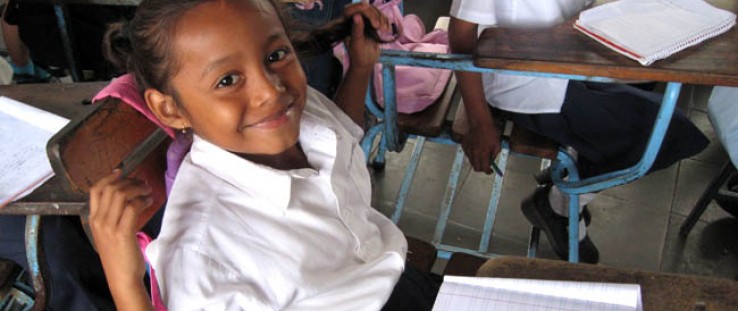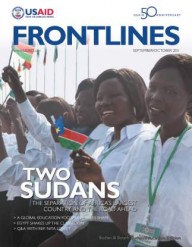 A girl in school writes out the words, then draws the concepts. Through fun activities, learning can be made easier.
USAID
A girl in school writes out the words, then draws the concepts. Through fun activities, learning can be made easier.
USAID
 A girl in school writes out the words, then draws the concepts. Through fun activities, learning can be made easier.
USAID
A girl in school writes out the words, then draws the concepts. Through fun activities, learning can be made easier.
USAID
Children in the developing world often go to great lengths just to go to school, often commuting miles on foot. Dilapidated schoolhouses, tents, the shade of a tree, or even open fields frequently serve as classrooms. They struggle to finish homework by candlelight—hoping they can find the paper and pencil to finish assignments. Other children cannot attend school due to armed conflict or natural disasters.
So it stands to reason that these courageous efforts to obtain an education should result in becoming literate and having more opportunities. But, the evidence often shows otherwise. Improving access alone does not necessarily lead to improved learning, future opportunities, and career success.
USAID’s new Education Strategy, released in February 2011, commits the Agency to ensuring that its education programs deliver measurable and sustainable results and focus squarely on measureable achievement in the early grades, access to education that has been disrupted due to conflict and crisis, and support for higher education and workforce development.
The five-year strategy lays out a way forward for USAID’s education activities that depart from past efforts that took a more broad-brush approach to education programming. In particular, it provides for measurable, time-bound targets.
One Strategy, Three Goals
Three goals anchor the new strategy. The first goal aims to improve reading skills for 100 million children in the primary grades by 2015; the second goal supports higher education and workforce development to generate workforce skills relevant to a country’s development; and the third goal seeks to provide equitable access to education for 15 million children and young adults by 2015.
Today, more than 70 million children do not go to school. But there are many millions more who attend school but are not learning the basic education skills they need to survive in a modern, globalized world. The statistics are jarring. Recent studies found that more than 70 percent of primary school children in Mali, Pakistan, and Peru still cannot read at grade level after having regularly attended classes. Studies in Mali and Uganda revealed that more than 50 percent of students at the end of grade two could not read even a single word.
“Such problems need to be identified and corrected far earlier,” said Richard Whelden, the new director of USAID’s Education Office within the Bureau for Economic Growth, Agriculture and Trade. “The new Education Strategy challenges USAID and the donor community to focus not on inputs to school systems,” Whelden said, “but on the key outcomes education investments are meant to produce. This principle guides our new strategy as well as the rest of USAID’s development agenda.”
Rather than focus on getting students to class, the first goal of the strategy addresses the quality of the lessons those children receive as measured by student achievement.
“At the end of the day, to achieve the first goal, the number of teachers we train, the classrooms that get renovated, and the textbooks that get delivered are inconsequential if they cannot be shown to result in children learning,” said David Barth, the former director of USAID’s Office of Education who helped design the new strategy.
The second strategic goal supports higher education and workforce development, ensuring that students obtain relevant skills as they become adults and go in search of work and careers. As globalization creates an increasing demand for higher-level skills, a growing number of young people in developing countries find themselves without the relevant assets to realize their potential and fully participate in and contribute to economic development.
USAID wants to expand student access to the kinds of skills they will need, particularly by strengthening host-country institutions; improving the relevance of education, training, and applied research; fostering strategic partnerships between U.S. and host country institutions; and promoting public-private collaborations.
The third goal focuses on providing equitable access to education in environments affected by conflict and crisis for as many as 15 million children and young adults by 2015. Nearly 40 million children do not attend school because they live in countries affected by armed conflict. Millions more have been displaced by either fighting or natural disasters like the flooding that decimated large swaths of Pakistan in the summer of 2010 or the devastating earthquake that struck Haiti earlier that same year. Children who live in lawless and crime-plagued communities also often cannot attend school.
Working directly with these children at the primary or even secondary level of their educations—even in the midst of dire circumstances—has been shown to reduce the likelihood of future conflicts. A growing body of research looking at Rwanda, Kosovo, Nepal, and other countries suggests the inverse—that poor quality education is a contributing factor to outbreaks of conflict.
Improving equitable access represents the commitment of USAID to reach learners in the most challenging and difficult environments and the understanding that it may serve as a first step towards achieving stability. In total, a significant portion of USAID’s education programs take place in conflict and crisis-affected environments. Overall, the new USAID Education Strategy directly responds to the principles of USAID Forward by providing clear focus areas based on evidence of effectiveness.
“USAID’s efforts to assess and reshape its education strategy required that we make a number of hard choices regarding program focus. However, I am confident that this more focused strategy, with its increased emphasis on the quality of learning outcomes, equitable access in conflict and crisis contexts, and support for higher education and workforce development will advance the Agency’s overall mission to help the next generation in the developing world,” said Whelden.









Comment
Make a general inquiry or suggest an improvement.